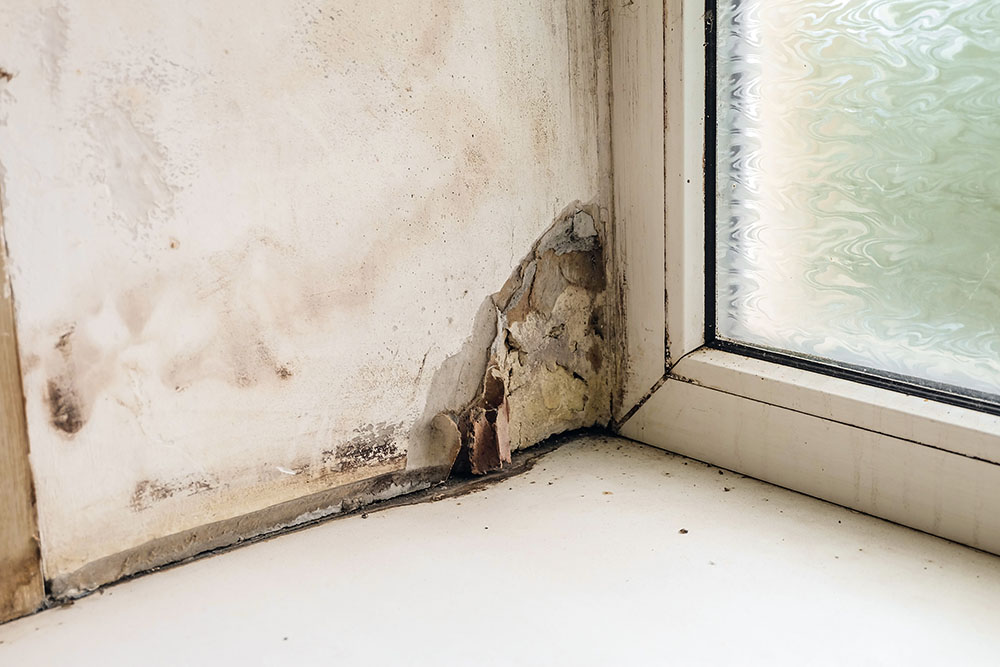What Is The Difference Between Dry Rot And Wet Rot?

CONTENTS
- Understanding dry rot and wet rot
- Dry rot: causes, characteristics, and consequences
- Wet rot: causes, characteristics, and consequences
- Remediation techniques for dry and wet rot
- Treating dry rot
- Treating wet rot
- Preventative measures against wood decay
- Dry rot prevention
- Wet rot prevention
- Linking wood decay to mould growth
- Frequently asked questions
- Get in touch
Dry rot and wet rot are dangerous results of a mould infestation, stealthily breaking down wood from within. Knowing the differences between the two can help you identify them immediately, preventing structural damage and stopping mould infestation.
Our team at ICE Cleaning offers mould cleaning services, paving the way for mould prevention efforts across the UK in private homes and social housing. We utilise the latest technology that identifies the root cause of mould, guiding you in preventing its return.
Read on to learn the difference between dry and wet rot, why they are different, how to spot them early on and discover ways to protect your home from them.
Understanding dry rot and wet rot
Understanding the differences between dry and wet rot is crucial in property maintenance. These two forms of wood decay can have significant implications for structural integrity if left untreated.
Dry rot: causes, characteristics, and consequences
Dry rot (Serpula lacrymans) is a fungal decay that affects timber in buildings with persistent dampness.
Dry rot requires a relatively high moisture content (typically above 20%) to initiate growth, feeding on cellulose within the wood, and leaving behind a brittle structure with fractures.
The first sign of dry rot often comes in a musty odour. On closer inspection, you may notice changes in the texture and colouration of affected timber. Infected wood typically becomes brittle and crumbly, with darkened or bleached patches appearing on its surface.
The key distinguishing feature of dry rot lies in its ability to spread through materials other than timber - even masonry - seeking new food sources. This makes it particularly destructive, compromising structural stability by decaying load-bearing wood.
If left untreated, dry rot has severe implications for any wooden structure within your home. The degradation process weakens timbers, leading to potential structural failure over time - a costly and hazardous issue for occupants' safety.
Identifying dry rot requires expert knowledge due to its complex life cycle and similar appearance to other wood decays.
Therefore, it is advisable to seek professional help from specialist cleaning services like ICE Cleaning, who can diagnose the issue correctly and suggest appropriate remedial actions.
Wet rot: causes, characteristics, and consequences
Wet rot (Coniophora puteana) occurs more frequently but is less harmful due to its inability to spread beyond the initial area affected by dampness. Like dry rot, it thrives under conditions with substantial moisture levels; however, unlike dry rot, it does not extend through non-timber materials.
The main characteristic signs include discoloured or darkened timber, which feels soft when touched or prodded with a sharp object like a screwdriver. A cracked surface resembling peeling paint is a sign, along with a musty smell, suggesting the presence of mould growth.
Apart from visual indicators, wet rot produces a musty odour, permeating in affected areas. This smell arises from the fungal spores breaking down cellulose and lignin – two primary components found in wood - resulting in moisture release into the surrounding environment.
It can significantly affect the structural integrity of wood within residential properties and requires immediate attention to prevent further damage. If left untreated for prolonged periods, this can lead to significant deterioration where the wood might even disintegrate under pressure.
Mould growth linkage
Both dry rot and wet rot are linked to mould growth, as all these conditions thrive in damp environments. Moulds can lead to various health issues, such as respiratory problems and allergic reactions. Therefore, managing the moisture levels within your property is crucial for structural reasons and maintaining indoor air quality.
Remediation techniques for dry and wet rot
Dry rot and wet rot are two common types of wood decay that can cause significant damage to residential properties.
Understanding the distinctions between these two forms of rot, their causes, characteristics, potential consequences, and remediation techniques is essential for homeowners, landlords, and tenants.
Treating dry rot
The first step in treating dry rot involves identifying its source by conducting a thorough damp proof survey by a company like ICE Cleaning. Once identified, any affected timber is removed and replaced with pre-treated wood.
The next stage involves drying out affected areas using dehumidifiers or heaters if necessary. Following this process, chemical fungicides are applied to kill off remaining spores. This helps to create an uninhabitable environment for further growth of dry rot fungi.
Treating wet rot
The process for addressing wet rots involves various measures; conducting an inspection to recognise the type of rot present, extracting the affected wood, implementing a drying process within the affected region, and treating the remaining area with fungicidal substances.
Additionally, measures taken must prevent future outbreaks, including fixing leaks or addressing other sources of moisture ingress within your property.
Mould growth, often associated with both types of wood decay, requires specialist cleaning services to ensure complete removal and the prevention of future occurrences.
Preventative measures against wood decay
When fighting against wood decay, understanding and preventing both dry rot and wet rot are integral.
These two forms of fungal decay can cause significant damage to timber structures if left unchecked. Early detection, correct identification, and professional remediation are key to preventing damage.
Dry rot prevention
Dry rot is a wood-destroying fungus that thrives in moist environments with poor ventilation. It requires a moisture content of 20% or above in the wood it infests. To prevent dry rot:
- Maintain good ventilation: Ensure your property has adequate air circulation to prevent a build-up of damp conditions conducive to dry rot development.
- Regularly check for leaks: Water ingress from faulty plumbing or roof leaks can create ideal conditions for this fungus. Regular maintenance checks help identify potential issues early on.
- Treat exposed timber: Apply fungicidal treatments on any exposed timber as a proactive measure against possible infestation.
Wet rot prevention
Wet rot refers to several species of fungi which favour very damp conditions - typically when wood moisture content exceeds 50%. Preventive measures include:
- Avoid direct contact between soil and timbers: This prevents ground water from being absorbed by the wooden elements in your building structure.
- Ensure proper drainage systems: Good exterior drainage will prevent water pooling around structural timbers.
- Routine inspections and prompt repairs: Detect signs such as discolouration, softness or cracking early before extensive damage occurs.
The key to preventing dry and wet rot is controlling moisture levels. Regular maintenance checks are essential for early detection of any potential issues. By taking these preventative measures, you can protect your building from the destructive forces of wood decay.
Linking wood decay to mould growth
Understanding the nature and causes of wood decay is crucial in building maintenance. The common forms of dry and wet rot can lead to significant structural damage if left untreated. Notably, these conditions also create an environment conducive to mould growth.
Mould growth: a common thread
A key factor linking dry rot, wet rot and mould growth is excessive humidity or moisture within a building's material.
Mould spores thrive in similar environments favoured by both types of fungal decay, so their presence may indicate underlying damp that could potentially foster rots if not addressed promptly.
Potential consequences
- Structural damage: Both dry and wet rot can compromise the structural integrity of a building, potentially leading to costly repairs.
- Health risks: Mould exposure may lead to health problems like allergies and respiratory conditions.
Understanding the distinctions between dry rot and wet rot is essential in preventing these forms of wood decay.
The same environmental conditions also contribute to mould growth, underlining the nature of these issues within building maintenance strategies.
Frequently asked questions
What's the difference between wet rot and dry rot?
Dry rot thrives in low-moisture conditions, eats wood more aggressively, and can travel through masonry. Wet rot needs higher moisture and usually stays localised to damp wood.
What are the signs of wet rot?
Look for darker timber, a musty smell, softness when pressed with a screwdriver, or visible fungal growth. These indicate wet rot.
Will wet rot spread once dry?
Wet rot will not spread after drying out because it requires constant moisture to survive and grow.
Does dry rot need to be removed?
Dry rot is destructive; you must remove infected wood and treat surrounding areas to stop it from spreading.
Get in touch
At ICE Cleaning, our mould remediation services include treating surfaces affected by wood decay at rot. We also offer damp surveys to ensure that your home does not experience another mould breakout, discovering the root cause and advising you on prevention.
To learn more about our mould removal services, get in touch with our team today at 0208 066 0360 or enquiries@icecleaning.co.uk. Our services are available nationwide, 24/7, all year round, so we can assist you no matter where you are and if you are experiencing an emergency.

Speak with me today,
I’m here to help
By asking you a few questions either via phone or email I can immediately provide a realistic estimation of the cost.
You’re in good company. We’ve cleaned for the following commercial clients… View all

Why choose us?
- Cater to a wide variety of cleaning situations
- Nationwide coverage, available 24/7
- Cater to commercial and domestic clients
- Free survey provided prior to quotation
- Emergency response team
- Offer a bespoke service designed to suit all your needs
- All technicians hold professional health and safety qualifications, including BICSc, IOSH, Dewpoint Professional & Safe Contractor
We’re fully accredited
We place best practise, professional expertise and health and safety at the core of our business. We’re fully compliant with all legal obligations. You can view a list of our accreditations below, or visit our Health & Safety page for more information.











-RGB-small.1707319151.jpg)




















